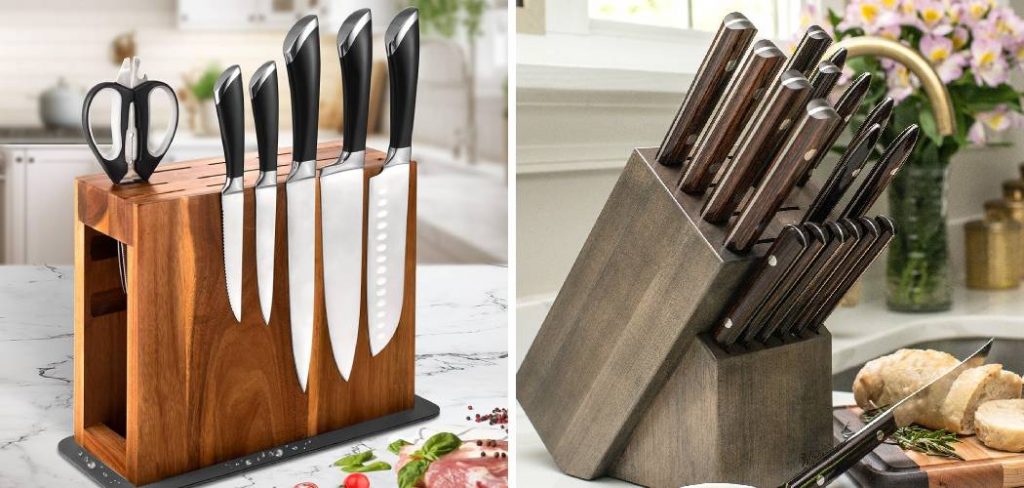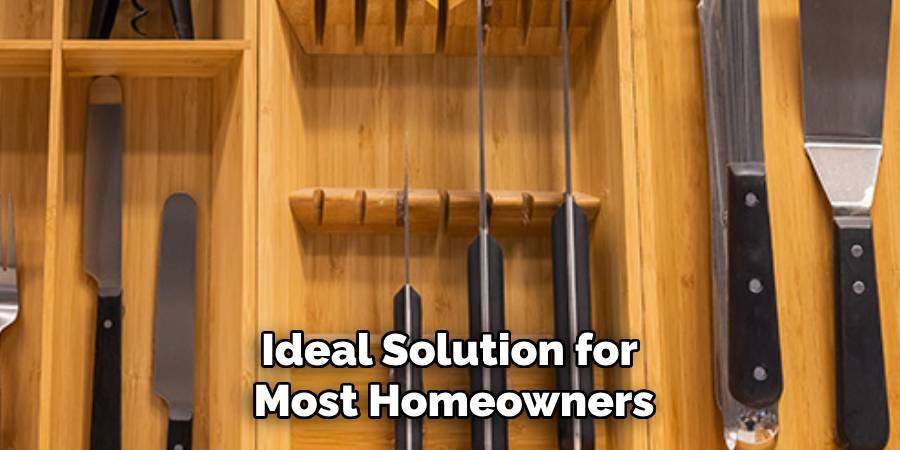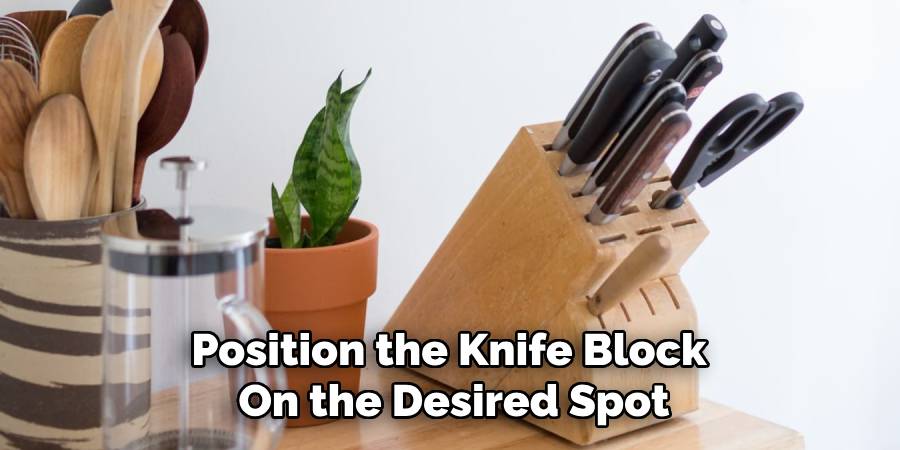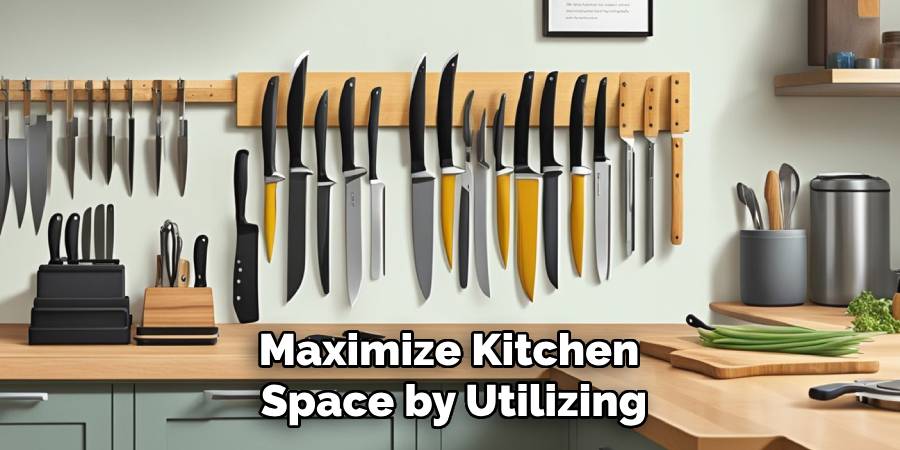A knife block is an essential tool in any kitchen, serving as a convenient and safe way to store knives. However, an unstable knife block can pose serious risks, such as accidental falls that may lead to injuries or damage to your kitchen tools. Securing a knife block is not just a matter of organization but a critical step in ensuring kitchen safety and keeping knives easily accessible during meal preparation. Common problems with unstable knife blocks include sliding on smooth countertops, tipping over due to imbalance, or occupying counter space inefficiently.

These issues can create unnecessary hazards and inconvenience in your daily kitchen routine. This article explores practical and DIY solutions on how to secure a knife block on countertop, providing you with effective methods to eliminate instability and enhance safety. Follow along to discover the best approaches tailored to your kitchen setup and countertop material.
Choosing the Right Spot for Your Knife Block
Considering Accessibility and Safety
Placing your knife block is crucial for ensuring both efficiency and safety in your kitchen. Ideally, the knife block should be positioned within easy reach of your main cooking area, near your prep station or stove. Having your knives readily accessible allows for smoother meal preparation and reduces the need to walk around the kitchen with sharp blades in hand. Also, place the knife block safely from the counter’s edge. This precaution helps to avoid accidental bumps or falls, which could result in injuries or damage to your knives.
Avoiding High-Traffic Areas
It’s equally important to position the knife block in an area less frequented by others in the household. Keep it out of reach of children and away from areas where they might be tempted to grab it, like near snack stations or accessible countertops. Also, avoid placing it too close to frequently used appliances, such as toasters or mixers, to reduce the risk of accidental contact or clutter during busy kitchen moments.
Evaluating Countertop Material

Your countertop material plays a significant role in determining how secure the knife block will be. To keep the block in place, smooth and slippery surfaces such as granite, marble, or quartz may require additional securing methods, such as non-slip mats or adhesive strips. On the other hand, wooden or textured surfaces generally provide better grip and stability, reducing the need for extra measures. Assessing the unique properties of your countertop ensures a safer and more stable knife block setup.
How to Secure a Knife Block on Countertop: Using Non-Slip Pads or Rubber Feet
Non-slip pads or rubber feet are an excellent solution for enhancing the stability of your knife block. By creating additional friction between the block and the countertop, they help prevent accidental shifts or falls, ensuring both safety and convenience in your kitchen.
How Non-Slip Pads Work
Non-slip pads are adhesive-backed and act as a buffer between the knife block and the countertop surface. These pads are available in various materials, including silicone, rubber, or cork, each offering durable friction. They are particularly effective for smooth surfaces like marble or quartz, where sliding might be an issue.
Installation Steps
- Clean the bottom of the knife block: Ensure that the surface is free of dust, grease, or debris for better adhesion.
- Attach the pads evenly: Place non-slip pads on all four corners of the base, ensuring equal spacing to maintain balance.
- Test for movement: Place the knife block back on the countertop and gently nudge it to confirm stability.
Advantages of Non-Slip Pads
Non-slip pads offer an inexpensive and hassle-free way to secure your knife block. Their simplicity makes them an ideal solution for most homeowners, and their adaptability allows them to work effectively on a wide range of countertop surfaces. Additionally, they prevent damage to both the countertop and the knife block by reducing abrasive movement, making them a practical and protective choice for your kitchen setup.

Using a Weighted Base for Extra Stability
How Weighted Bases Work
A weighted base enhances the stability of a knife block by lowering its center of gravity, significantly reducing the risk of tipping. This method is particularly effective for lightweight knife blocks or in environments where countertop vibrations are common, such as households with children or busy kitchens. Weighted bases are usually created using materials like adhesive lead weights or compact sandbags, which can be discreetly affixed to the bottom of the knife block.
Steps to Add a Weighted Base
- Attach adhesive lead weights: Secure adhesive lead weights evenly to the underside of your knife block. These can be purchased in hardware or home improvement stores and come in various sizes to accommodate your needs.
- Use a non-slip mat: Place a non-slip mat underneath the knife block to prevent it from sliding on smooth surfaces for optimal stability. It works in conjunction with the weighted base to provide a secure grip.
When to Use This Method
A weighted base is an excellent solution for kitchens with frequent countertop vibrations, ensuring that the knife block remains secure despite movement. It is also ideal for lightweight knife blocks that may be more prone to tipping when occupied with multiple knives.
Securing the Knife Block with Brackets or Screws
For maximum security, permanently attaching your knife block to the countertop using L-brackets or small screws is an effective solution. This method ensures the knife block remains completely stable, even in high-traffic kitchens or areas with frequent movement. While it offers exceptional stability, it requires drilling, which may not be suitable for renters or those unwilling to modify their countertops.
Installation Steps

- Mark the placement of the brackets: Position the knife block on the desired spot and use a pencil to mark where the L-brackets or screws will be attached to the countertop.
- Drill small holes: Using a drill, carefully create small pilot holes on your markings to prevent splitting or cracking the countertop material.
- Attach the brackets: Secure the L-brackets or screws into place using a screwdriver, ensuring a snug fit. Double-check that the knife block is tightly secured and does not wobble.
Pros and Cons
This method’s primary advantage is its enhanced security and stability, making it virtually impossible for the knife block to tip over or shift. However, it is a permanent solution that involves drilling, which may not be feasible in all kitchens, especially for renters.
Alternative Storage Solutions to Replace a Knife Block
When a knife block isn’t suitable for your kitchen setup, several alternative storage solutions offer safety, accessibility, and space-saving benefits.
Wall-Mounted Magnetic Knife Strips
Magnetic knife strips are an excellent option for keeping knives within easy reach while saving valuable counter space. These strips can be mounted on walls or backsplash areas, allowing you to display knives in an organized and visually appealing manner. Additionally, they prevent blade dulling by avoiding contact with other utensils or surfaces.
Drawer Knife Organizers
Drawer knife organizers provide a practical solution for those looking for a discreet and child-safe option. These in-drawer holders are specifically designed to keep knives securely in place, preventing them from sliding or shifting. This option is ideal for minimalist kitchens and families with young children, as it keeps sharp tools out of sight and reach.
Under-Cabinet Knife Racks
Under-cabinet knife racks are designed to maximize kitchen space by utilizing the often-unused area beneath cabinets. These racks securely hold knives and keep them readily accessible without cluttering your counters. They are perfect for smaller kitchens or those seeking a modern, functional aesthetic.

Each solution offers unique advantages, catering to different kitchen layouts and personal preferences.
Conclusion
Understanding how to secure a knife block on countertop is essential for maintaining a safe and organized kitchen. The best methods include using non-slip pads, adhesive strips, weighted bases, or permanent brackets to stabilize the knife block. Each approach adds a layer of safety, reducing the risk of accidents caused by slipping or tipping. Securing your knife block also ensures easy access while protecting your knives from unnecessary damage. When choosing a method, consider your countertop material and kitchen setup to find the most suitable solution. A secure knife block ultimately enhances both safety and efficiency in your kitchen.
Professional Focus
Angela Ervin, a former interior designer turned blogger, specializes in kitchen design and renovations. Through her website, she blends her passion for cooking with design expertise, sharing practical and creative ideas. Known for balancing functionality and beauty, Angela’s insightful content has made her a trusted voice in home design and lifestyle.
About the Author
Angela Ervin, an experienced interior designer and blogger, combines her passion for kitchen renovations with storytelling. Living in Petersburg with her family, she enjoys cooking and testing her projects firsthand. Known for her humor and relatable style, Angela shares creative, functional design insights through her content, making her a trusted voice in home design.
Education History
University: Virginia Commonwealth University
Degree: Bachelor of Fine Arts (BFA) in Interior Design
- Angela’s education at VCU focused on mastering core interior design principles, including spatial planning, color theory, materials selection, and sustainable design practices.
- She gained hands-on experience through studio projects and collaborative design exercises, which honed her ability to create functional and aesthetically pleasing environments.
- Her coursework also emphasized problem-solving and practical applications of design, preparing her for real-world projects like her self-directed kitchen renovations.
- The program’s strong foundation in both technical skills and creative expression shaped Angela’s ability to seamlessly integrate form and function in her work.
